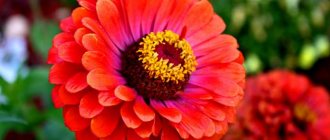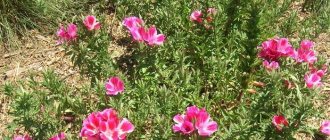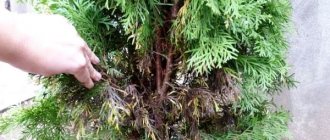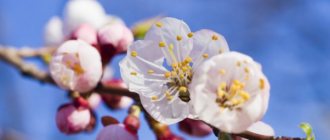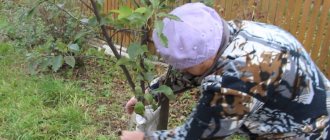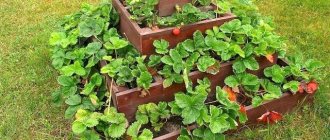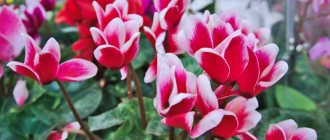Cyclamen flower - description
Cyclamen belongs to the Primrose family. According to various sources, the genus Cyclamen includes from 20 to 55 species. Every year, more and more cultivated varieties are added to this number, which differ from each other in appearance and other characteristics. Representatives of the genus can be found in the wild in Central Europe, the Mediterranean and Asia Minor.
Cyclamen is a perennial herbaceous plant with a thick tuberous rhizome, in some species similar to a turnip. The leaves grow directly from the top of the rhizome on long thin petioles and are round in shape with a heart-shaped base. The surface of the leaf is colored green. It is decorated with a pattern in the form of a wide large ring of a darker shade, light stains and silver inclusions.
How it blooms
Cyclamen blooms in winter or early spring. Its flowers, depending on the type, can be drooping or directed upward and exude a pleasant aroma reminiscent of honey, lily of the valley or violets. They are formed on thin graceful peduncles and have a regular shape. In most species, flowers contain 5 bent petals, which can have a wide variety of colors. In cultivation there are varieties and species with pink, lilac or purple flowers. Modern hybrids boast incredible color and flower shape. Among the cultivated varieties there are terry and even black Cyclamens.
Most domestic Cyclamen are the result of selective breeding and are descended from the Persian Cyclamen. They have a simpler character and are slightly less demanding in terms of living conditions.
Reviews
Anna Vasilievna. “I received one flower as a gift on March 8th. But then I bought more. Different colors. It’s especially nice that it blooms when other flowers are resting. I don't see any problems with care. Even during the dormant period there was no complete fall of leaves. I don’t even try to figure out the varieties. It’s a little difficult for specialists too. They bloom incomparably."
Vasilisa. “Many people say that the flower is problem-free. But not for me. One froze during transportation home. And disappeared. The other bloomed for a couple of months after March 8th. I replanted it and all I see are new leaves. But I hope to grow flowers too. I'm probably not doing everything right. But I love him just the way he is.”
Igor. “Cyclamen blooms from spring to autumn to spring. Just. Otherwise, there are not enough colors against the backdrop of snow outside the window. They are also pleasing to the eye. And it’s easier to get along with them than with people.”
How to care for Cyclamen at home
Cyclamen certainly cannot be called an easy plant to maintain. When purchasing it, first of all, you should think about how suitable the home conditions are for growing Cyclamen, otherwise the beautiful flower will turn into a withered bush in a short time and die.
What to do after purchase
Most often, Cyclamen appear on sale in the fall or winter, when they are at the peak of their decorative potential. Many people buy it, bring it home or give it to friends, completely unaware of the peculiarities of this plant.
First of all, you need to choose a healthy plant, so when purchasing, pay special attention to its appearance. The upper part of the Cyclamen tuber should be covered with smooth skin. The leaves of the plant must look fresh and alive, you should not pay attention to specimens with withered leaves, and in order for Cyclamen to delight you with its flowering for as long as possible, it is better to choose a bush with a large number of unopened buds.
Don’t be alarmed if a plant brought to a new home droops slightly after a couple of days. He needs to get used to the new place and conditions. At this time, the owner needs to try to create the most comfortable conditions for the flower: find a well-lit, cool place for it and, if necessary, slightly moisten the soil. It is better to water freshly purchased Cyclamen through a tray or by immersion in a shallow container, then the plant will absorb exactly as much water as it needs. For the first 3-4 months after purchase, the flower is not fed, since before sale the plants are watered abundantly with fertilizers so that they can bloom magnificently and for a long time to maintain their marketable appearance.
After flowering ends, Cyclamen can be transplanted into a new, lighter substrate. It is highly undesirable to replant a plant after purchase, since it is already under severe stress and can drop its buds and be sick for a long time.
Lighting
At home, Cyclamens are kept in a well-lit place, but protected from direct sunlight. You can place a pot with a flower on the windowsill of a south-facing window, but shade it from the bright sun with a light curtain or move the flower out of the sun for a while. The most favorable place for Cyclamen will be the windowsill of a southwest or southeast window. On a north window, a light-loving flower may get bored. In this case, it needs additional illumination with phyto-lamps for 12-14 hours a day, since the meager sun of temperate latitudes in the cold season will not be able to provide it with energy for flowering. Then the Cyclamen will not bloom so magnificently, and the buds themselves will appear later.
Content temperature
Creating a suitable temperature regime for Cyclamen is the most difficult moment in a city apartment. This plant needs coolness, and at normal room temperature it begins to wither and crumble. In summer it can be grown at +20-+240C, but the plant must be shaded and is best kept in the open air, on a balcony or on the windowsill of an open window. In winter and autumn, when Cyclamen grows and blooms, it needs coolness, so it is kept at +10-+140C.
It is necessary to ensure good air circulation, but be wary of drafts and sudden temperature changes, so when ventilating, the flower is rearranged or taken out of the room. Some hybrids can grow well at room temperature, but then they need to be acclimated gradually and make sure that the room is not too hot. You can choose the coldest window sill and ventilate the room more often.
Humidity
In winter, Cyclamens are moved away from working batteries, since they cannot tolerate dry air. During leaf growth, it is recommended to spray the plant with fine water mist. When buds appear, spraying is stopped, then it is better to place a humidifier next to the plant or place the pot on a tray with moss or expanded clay.
How to water
Cyclamens tolerate a lack of moisture better than excessive watering, so you need to water the flower carefully, in small portions. For irrigation use soft lukewarm water. When watering, do not get on the shoots and tubers of the plant, otherwise this may lead to rotting. It is better to water Cyclamen through a tray, then the roots will be able to absorb enough moisture.
In summer
In the warm season, until Cyclamen blooms, it is watered in small portions only to keep the earthen ball slightly moist. You cannot overdry the substrate, otherwise the roots will die, and the rhizome will go into hibernation, and it will be very difficult to bring it out of this state.
in winter
In autumn, Cyclamen begins to grow actively. At this time, it is watered frequently, in small portions. It is necessary to keep the contents of the pot slightly moist, avoiding waterlogging of the substrate.
Fertilizer and feeding
Fertilizing begins in the fall, when fresh leaves grow from the tuber after hibernation. To do this, you can use special preparations for Cyclamens or alternate mineral and organic fertilizers. The frequency of feeding is 2 times a month. After flowering, when the plant begins to dry out the leaves, stop all feeding.
When choosing a fertilizer, it is important to pay attention to the amount of nitrogen, since a high content of this element leads to rotting of the tubers. Nitrogen preparations should be administered only at the beginning of the growing season. Cyclamen will need more potassium and phosphorus before flowering.
Rest period
Some time after flowering, Cyclamen begins to dry out the leaves and gradually all its green parts die off. Then stop feeding and gradually reduce watering. By the time all the green parts of the plant have withered, the number of waterings is reduced to 2-4 times a month.
During hibernation, the pot with Cyclamen is placed in a dark, cool place and kept at a temperature of about +17-+200C. In autumn, the pot with the plant is transferred to a warm place and watering is resumed. A signal that the plant is breaking dormancy will be the appearance of fresh leaves. Plants need to be accustomed to the bright sun gradually so that the tender leaves do not get scorched.
Possible problems in growing in the garden
At any stage of growth, improper care can lead to problems. For example, if you prescribe a cyclamen bulb, then later it may not live up to the gardener’s hopes. Another problem is modifications of leaves and flowers during growth. Why do cyclamen leaves stretch out?
- hot air;
- excess moisture;
- high air humidity.
Bicolor alpine violet
Cyclamen is rightfully considered one of the most common flowers. It is difficult to meet a person who does not know the meaning of cyclamen and has no idea about its appearance, since it is completely unlike any other.
Reproduction
Cyclamens are propagated in several ways: seeds, tubers, leaves and rosettes.
Seeds
To get seeds at home, you need to transfer pollen from one flower to another using a soft brush. The procedure is repeated for several days. After this, the flower stalks will begin to bend, and a seed pod will begin to form in place of the flower. When the seed box is ripe and dry, it is collected, the seeds are taken out and they are soaked for 24 hours in warm water with growth stimulants.
After this, you need to prepare a wide bowl, on the bottom of which a thick layer of small pebbles, perlite or broken bricks is poured. Then pour 6-7 cm of substrate. For sowing, a soil mixture for succulents or a soil mixture consisting of equal parts of leaf soil and peat, which is moistened with a sprayer, is suitable. The seeds are distributed over the surface of the soil and sprinkled with a layer of soil. The dishes are covered with film on top and placed in a bright, warm place, kept at a temperature of about +18-+200C. The greenhouse needs to be ventilated daily and the surface of the soil should be periodically moistened with a spray bottle. If everything is done correctly, then after 1.5 months the first shoots will begin to appear. The hotter the room, the longer the seeds will take to germinate. When sprouts begin to appear on the surface of the soil, the shelter is gradually removed, and the dishes with seedlings are moved to a cooler place and kept at a temperature of about +15-+170C. When the seedlings grow a couple of true leaves, they are transplanted into separate cups with a suitable soil mixture and the small tubers are lightly sprinkled with soil. This is necessary so that the rhizome develops well and does not suffer from external influences at such a tender age. 7-10 days after the first picking, fertilize with fertilizer for flowering crops in a dosage reduced by 50%. At the end of spring and beginning of summer, grown Cyclamen are transplanted into permanent pots and the upper part of the tuber is slightly exposed.
Tubers
Domestic Cyclamens can also be propagated by dividing adult tubers into 3-4 parts or separating daughter nodules. Tubers are separated only after flowering. Daughter shoots can be carefully separated from the mother rhizome and planted in separate cups. Adult tubers are taken out of the ground, dried and divided into several parts with a sharp, clean knife. In each plot, at least one growing point and part of the roots should remain, and the cut areas should be sprinkled with coal. After this, the tubers are planted in separate containers with a calcined, moist substrate and buried 2/3. Until the plots take root, watering should be minimal, otherwise the tubers will begin to rot.
Leaf
European Cyclamens can be propagated by leaves. Then the leaves must have their own roots; for this they are separated and germinated in a glass of water, after which they are planted in a pot with a substrate. This method is very complicated; most often the leaves do not take root, but simply rot at the base and dry at the top.
Rosette
Adult Cyclamens can be propagated by rosettes, which are broken off at the base and planted in the substrate. You cannot break off more than one rosette from a plant, otherwise the mother bush will die. The surface of the dish is covered with a transparent cap and placed in a warm place. After 2 weeks, the plants will take root and begin to grow. Persian Cyclamen are very difficult to reproduce by rosettes, so this method is most often used for European Cyclamen.
Care
If the bush was given as a gift or was purchased in a store, immediately after purchase it is necessary to inspect the “green pet”. The foliage should have a clear pattern and be elastic to the touch, the stem should be dense, and a healthy tuber should be visible from the soil.
Lighting
Alpine violet loves light, so it is better to place pots on window sills with windows facing west or east . They should not be exposed to direct sunlight, but to soft daylight.
In the summer heat, the pots are moved to the balcony or street, loggia or veranda, protecting the pets from sunburn with gauze or a curtain. If this is not possible, then the room needs to be ventilated more often.
Temperature
In order for cyclamen to bloom longer and more abundantly, it requires coolness. Throughout the year, the flower requires temperatures from +6 to +15 degrees, not higher. Therefore, to grow primrose at home, you should choose the shape and type of flower that matches the climate of the grower.
How to water?
Although this plant loves moisture, the top layer of soil must dry out between waterings .
The best method in which moisture will not reach the growing point and fungal diseases will not develop is bottom watering. That is, the pot must be placed in a tray filled with fresh water. Cyclamen will absorb as much moisture as needed.
The flower needs a high level of humidity, which must be maintained throughout the day. The best option is systematic spraying, especially in the summer heat. Spraying with cool water (not cold) can reduce the temperature by 3 to 4 degrees.
What to feed?
The butterfly flower is fertilized during the growth period, with a pause of a couple of weeks. Any liquid mineral solution for fertilizing flowering plants is suitable for feeding . But, it should be remembered that primrose does not tolerate high concentrations of mineral salts in the substrate.
How to transplant?
Every year, immediately after the plant awakens, it needs to be replanted.
And to do this, you need to select a tight pot in which the layer of soil between the walls of the container and the bulb will not be thicker than 3 - 3.5 cm. Cover the bottom with drainage: expanded clay, small crumbs of broken brick or gravel. Sprinkle a little with loosened substrate and transfer the onion with a lump of old soil onto it. Next, fill it with soil mixture so that the third part of the bulb is visible on the surface. Lightly compact the fresh soil and water it.
Priming
This exotic beauty grows quickly only in light soil, well loosened. Cyclamen will love the ready-made substrate for growing cacti . But you can prepare the soil composition yourself by mixing one equal portion of peat with turf and fine sand.
Trimming
There is practically no need for this procedure. Pruning should be carried out only to give a decorative appearance. You need to carefully cut off wilted foliage and those that begin to dry out. When cyclamen begins its dormant period, all the leaves turn yellow and dry out and they must be cut back to the tuber. There is no need to carry out any special processing.
During the flowering period, some leaves may turn yellow and flower stalks wither; they should be removed not by cutting, as stumps remain, which then rot, but by twisting - this method does not injure the tuber.
Cyclamen transplant
The procedure is carried out after flowering or in the fall after the end of the dormant period. Plants are transferred from the old pot to the new one, leaving 1/3 of the rhizome above the soil surface. Cyclamens grow quite slowly, so replanting is carried out approximately once every 2-3 years.
Priming
For planting, you will need light, nutritious soil that will drain well and not retain water. Also, tubers need a lot of oxygen to grow, so the soil mixture must be loose. You can plant Cyclamen in a special substrate for cacti and add a little sand, coal, coconut fiber or sphagnum to it. A suitable soil mixture can also be made from peat, leaf soil, humus and sand, taken in equal parts. The pH level should be around 5.5-6.0, but not higher than 6.5, since in this case the tubers may rot.
Pot
Choose a new pot that is wide but shallow, with good drainage holes. It is advisable that the new container be slightly larger than the previous one by 2-3 cm. If the rhizome fits well in the old pot and there is still enough space left on the sides, then you can simply replace the substrate with a fresh one.
Division into groups
- Miniature. Plants belonging to the first group are decorated with large flowers, reaching more than 4 centimeters in size. Sometimes even the flowers of this group have fragrant smells. For comfortable plant growth, a pot diameter of approximately 6-10 cm is required.
- Midi. Cyclamens of this group have medium-sized flowers and prefer pots with a diameter of 10-13 cm.
- Maxi. They are also called large-flowered or standard. A more suitable pot volume for them is 13-20 cm.
Read here Pelargonium - a description of growing at home. Breeding, transplanting and care during flowering (115 photos)
You can buy cyclamen flowers in specialized stores in September. It is valued for the fact that it does not stop blooming abundantly throughout the winter.
At the beginning of the spring period, the plant stops growing, the cyclamen turns yellow, and goes into rest. With proper care, the flower will delight you with blooming for many years.
Diseases and cyclamen with photos and their treatment
With proper care, Cyclamen rarely gets sick and is subject to attacks by pests. Modern hybrids have strong immunity, but if watering rules are violated, they can develop gray mold, which affects the rhizome. Then you need to remove the plant from the ground, wash it, remove damaged roots, treat it with fungicides and plant the plant in a fresh substrate. After this, Cyclamen is watered extremely carefully.
Also, with insufficient watering and low humidity in the room, the flower can become infected with spider mites. You can get rid of it with garlic water or insecticides.
The following signs may indicate that the plant is not entirely comfortable:
- The leaves turn yellow - if this happens after the end of flowering, then the plant is simply preparing for a period of hibernation. Then there is no need to take any action, since the process of the dying off of the green part for Cyclamen is a completely normal development cycle. In the fall, with properly organized “rest,” the plant will recover and begin to grow again. If Cyclamen leaves begin to turn yellow during the growing season and flowering period, this may mean the temperature is too high. You should find a cool place for it before the flowers begin to fade.
- Lack of flowering - this behavior is often the result of too high a temperature, low humidity and poor watering. It is worth aligning the parameters and then the plant will begin to actively grow buds. Pet Cyclamen can gradually get used to room temperature, but it takes a lot of time for them to do this.
- Leaf fall – leaves turn yellow, wither and fall off at high indoor temperatures.
- The leaves curl - the flower stands next to the radiator, and the hot dry air burns its foliage. It may also be a symptom of nutrient deficiency or spider mite infestation. It is important to examine the plant and determine the cause, then it will be possible to solve the problem in a short time. The affected parts are simply cut off.
- Peduncles wither - excessive watering, waterlogging of the substrate, rotting roots. In this case, the plant needs to be saved: removed from the ground, inspected, damaged parts removed and treated with a fungicide. After this, the rhizome can again be placed in the substrate, which is pre-spilled with a fungicide or calcined.
- Leaves and flower stalks wither - a sharp change in condition indicates that the cyclamen has frozen. It may suffer from drafts, so when ventilating it is removed away from open windows.
How does it reproduce
When growing cyclamen in the garden, it can be propagated by tubers; this is done in two ways. One is to divide the existing tuber, the other is to use daughter formations.
Germination of seeds
Using seeds, you can propagate the plant, but this will take a lot of time. In this case, the first flowers will appear only after a year; this time cannot be accelerated. To germinate seeds, you must first soak them for 12 hours in damp gauze or water and only then plant them in the ground.
Growing alpine violet from seeds
Rooting cuttings
The most effective way to grow a flower is to propagate it by cuttings. To do this, you need to carefully pinch off the shoot and plant it in open ground.
Cyclamen - popular species with names and photos
There are many domesticated varieties of Cyclamen, distinguished by the most incredible color and bud shape. Among the cultivated varieties and hybrids there are simple, fringed and even double Cyclamens.
Persian
The most cultivated variety. The leaves are heart-shaped, dark green with a marbled pattern in a lighter tone. Flowers can be white, purple, pink or red.
In indoor culture, the following varieties are especially popular:
- Victoria. The flowers are large, snow-white with a fringed crimson edge and speckles at the base.
- Barbarossa. The flowers are large, fringed, red and white with a strong aroma. They are located on long peduncles up to 15-20 cm high. The flowering period begins in autumn and ends in mid-spring.
- Rosemary. Forms a tall bush with long peduncles 15-20 cm high. The flowers are large, pale pink with a raspberry base and a strong pleasant aroma.
European
An evergreen plant with heart-shaped leaves colored dark green and silver. The underside of the leaves is purple. The flowers are fragrant, with petals twisted in a spiral, pink, purple or lilac.
African
Small bushes with green leaves on red petioles. The length of the leaf plate reaches 15 cm. The surface of the leaf is painted in rich green and silver colors. The flowers can be colored in different shades of pink and have a distinct pleasant aroma.
Alpine
A low plant with unusual carmine or pink petals bent at right angles with a purple speck at the base. The leaves are oval, light green. The flowers of this type of Cyclamen emit a pleasant aroma reminiscent of honey.
Caucasian
Subspecies of Cyclamen Kosskiy. Listed in the Red Book. It blooms in March-April with delicate lilac flowers. The leaves are round, heart-shaped, colored in dark and light shades of green.
Kossky
The species is native to the Middle East and Eastern Europe, and can also be observed on the islands of the Aegean Sea. The leaves are heart-shaped, decorated with ring patterns of light and dark stripes and colored in varying shades of green and silver. Flower petals are white, pink, lilac, red, brighter at the base of the bud.
Cypriot
It grows on rocky soils and grows up to 16 cm in height. The flowers are pink or white with a pleasant aroma. The leaves are heart-shaped, variegated, painted in different shades of green.
Ivy or Neapolitan
The leaves of this species are triangular in shape. The color and size of the leaves may vary slightly. The leaves of the plant have patterns of lighter or purple color in the shape of the letter V. The flowers are simple, directed upward, have a delicate lilac color and a strong but pleasant aroma.
Colchian or Pontic
Grows in the Caucasus. It is found in the mountains at an altitude of up to 800 m. The flower petals are deep pink, with a dark border and a delicate aroma. Due to diligent collection, this plant is classified as endangered and listed in the Red Book.
Kuznetsova
A rare species found only in the Crimea. Forms a small bush with green, wide-heart-shaped leaves, decorated with a light pattern on the outside. The reverse side is purple. It blooms in February-March with small drooping pink flowers with a delicate aroma.
Greek
The species can grow on rocky coasts and at altitudes up to 1 km above sea level. The leaves are oval or heart-shaped, combining different shades of green in their color. The surface of the sheet is decorated with patterns, spots and stripes of a lighter shade. The flowers are pink or carmine, with specks at the base. The subspecies of Greek Cyclamen with white flowers is listed in the Red Book and grows on the Peloponnesian Peninsula.
Alpine violet (European cyclamen)
And the name of cyclamen often contains the word “violet”. But alpine. Famous poets did not ignore this flower.
What type does it belong to?
Calling it a violet is not entirely correct . Or rather, even incorrectly:
- Perennial plant . Due to their massive growth in the Alpine mountains they received this name. Some other species grow along mountainous coasts: the Mediterranean Sea (even in the northeastern regions of Africa;
- Black Sea;
- Caspian Sea.
- Where the climate is warm and humid.
There are 22 known species of these plants . They are from the Primrose family. And they correctly call it Cyclamen.
Interesting! They have been grown as houseplants since 1656.
What is it called differently?
Cyclamen (lat. Cyclamen) . This is how it is correctly called among specialists and flower growers. These are not all of its names.
European cyclamen is one of the types of such flowers . The most famous. And quite often found in the collections of flower growers. It can bloom even without special dormant periods. Easier to grow in apartments.
There are other types. Which grow in natural conditions:
- African;
- Cypriot;
- Persian;
- Colchis;
- Grecum;
- Kossky.
But even experienced gardeners have problems growing some in apartments.
Important! Many of them are on the verge of extinction due to climate change. And man made his contribution to this process.
Detailed description of appearance
Corm plant . The tallest representatives reach no higher than 30-35 cm . Low-growing ones grow only up to 15 cm:
- Leaves: Green, heart-shaped and with a characteristic light pattern. They are also called marble spots in certain varieties;
- On petioles slightly more than 10-12 cm long, there are about a dozen of them in the bush;
- And the largest ones are no more than 15 cm in diameter.
- Their coloring suits every taste: from white to violet (scarlet, pink, lilac, purple).
What do the tubers look like?
The tubers of the flower and the addiction of wild boars to them gave another name - Pork bread :
- They are round with a small hole in the middle . Slightly similar to flattened beets. Or radish;
- Some species do not even have rounded outlines. With age;
- The roots are fibrous . They are not the same for everyone: From the bottom of the middle part of the tubers of Persian cyclamen;
- Cyclamen europaea has tubers on all sides.
Important! You have to be careful with the plant. Exposure to toxic substances even causes trembling in animals. Or crap. That's why they called it Dryakva. It even causes skin irritation. If you are caring without gloves. And keep away from small children.
Photo
Is Grandma's cyclamen a separate variety?
Discussions about “grandmother’s” cyclamen are being held among experienced gardeners. And those who consider themselves experienced. Its popularity and increased interest are not only in the name.
Grandmother's cyclamen is especially popular among beginners - caring for it is not at all difficult. He has virtually no rest period. And this is what interests flower growers most of all. Because they bloom longer.
Lovers of this flower with experience and age have become accustomed to the name “grandmother’s”. actually the species cyclamen Cyclamen purpurescens . It has been called that way for more than 15 years. Renamed from European.
In addition, it is capable of reproducing by root shoots . Flower growers call them fingers.
Should you keep cyclamen at home: signs and superstitions
First of all, it is worth noting that all parts of the Persian Cyclamen contain poisonous juice, which, if ingested, can cause nausea, vomiting and gastrointestinal upset. Therefore, you need to work with the flower with gloves and try to limit access to it for children and pets.
Many superstitions and signs are also associated with Cyclamen. Most of them note the positive effect of the flower on a person, but some have a completely negative color.
It is believed that Cyclamens are able to establish relationships in large families, where several generations live under one roof. This plant can also make its owner more romantic. Cyclamen red is especially endowed with this ability.
White Cyclamen is considered to be a symbol of financial well-being. To attract material wealth, it is recommended to put flowers in your wallet.
There is also a belief that Cyclamens have a bad effect on male energy, but in fact, this flower helps fight depression, gives strength and self-confidence, so this plant will be very useful to keep in the house for men of any age and status.
Cyclamens help women become softer and more romantic. Pink Cyclamens especially influence the emotional sphere. It is also believed that such a flower brings a long-awaited addition to the family.
At home, Cyclamen is recommended to be placed in the bedroom. At the same time, it shows its properties only to those who care for it, while others do not fall under the influence of the flower.
Is it possible to plant cyclamen outside?
Many people wonder, when planning to grow cyclamen, whether this flower can be planted in open ground. In Russia, it is not often possible to find cyclamen in a flower bed, since the flower is considered primarily an indoor plant. But, despite this, growing this flower in a flower bed is quite feasible, even with wintering.
Garden frost-resistant
Garden cyclamen blooms from early spring to late autumn, that is, almost all summer, it pleases with its unique attractive appearance. The plants differ in that they tolerate frost well. The plants are distinguished by juicy and durable tubers, which are located near the soil surface. The main advantage of frost-resistant garden cyclamen is its unsurpassed aroma, which will delight the gardener for a long time.
Cyclamen Elegans
Ivy-leaved cyclamen: planting and care in open ground
One of the most charming varieties is the ivy-leaved cyclamen. This flower is distinguished by excellent frost-resistant properties and delicate flowers. You can plant such cyclamens on the street or in the house.
Regardless of where it grows, the flower does not need any special care. It is enough to properly prepare the soil and water it in a timely manner, systematically feed it, remove faded flowers, and also treat it with acaricides several times.
Photos in the interior
With good care and favorable conditions, Cyclamen can decorate the windowsill of any home with bright colors. This plant gives a feeling of warmth and comfort, fills rooms with a delicate aroma and delights with its beauty all winter long. Growing Cyclamens is very exciting, and the wide variety of varieties and species allows you to organize a colorful flower bed right on your window.
Medicinal properties
In addition to its beauty, cyclamen has a pronounced pharmacological effect:
The juice of this plant eliminates all inflammatory processes that occur in the body.- Cyclamen is an excellent antiseptic, while having a detrimental effect on various pathogens.
- The juice has the ability to destroy viral infections in the body. Infusions with the addition of cyclamen juice should be taken for colds, developing migraines and inflammation of the maxillary sinuses.
- Cyclamen in contact with mucous membranes has a detrimental effect on microflora, so it should not be used for diseases of the gastrointestinal tract.
- Cyclamen juice works well in the form of rubs, which are used to eliminate pain that occurs with rheumatism, gout and other diseases.
Applying fertilizers to the soil
Caring for crops indoors also includes fertilizing. Such a brightly flowering plant undoubtedly requires regular feeding. In practice, universal complex fertilizers are used.
It is important to ensure that the fertilizer does not contain an excess of nitrogen compounds, which lead to rotting of the tubers. During the period of active flowering, all feeding of the flowering crop is completely stopped.
Pruning and dormancy
Cyclamen can be trimmed only after the end of the flowering period, and the entire body of the plant is cut off right down to the tuber. It is important to complete active fertilizing and watering at the same time as cutting off leaves and flowers, so as not to provoke the appearance of new shoots. In this way, the cyclamen is put into a dormant state until the next flowering season.
Cyclamens in pots make excellent outdoor decorations




